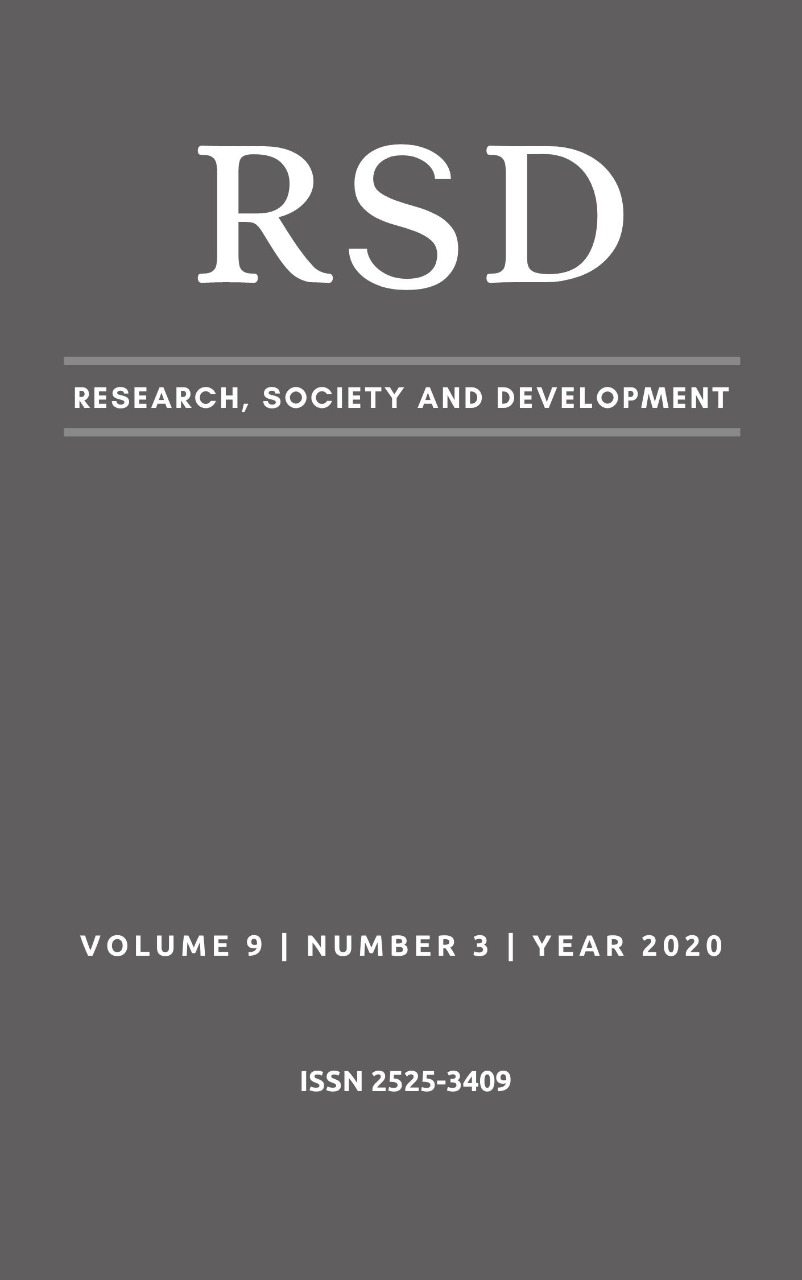Bioatividade da polpa e amêndoae sementes da Terminalia catappa Linn
DOI:
https://doi.org/10.33448/rsd-v9i3.2580Palavras-chave:
Amêndoa indiana, Antimicrobiano natural, Bioatividade.Resumo
As propriedades bioativas de frutos não convencionais têm sido de interesse de pesquisas recentes. O objetivo deste estudo foi avaliar a bioatividade da polpa e amêndoa da Terminalia catappa Linn através de sua atividade antioxidante e antimicrobiana contra microrganismos patogênicos. A polpa e a amêndoa foram analisadas quanto aos parâmetros físico-químicos de pH, aw, umidade, cinzas, carboidratos, proteínas e lipídios. Após a secagem, as farinhas da polpa e da amêndoa foram avaliadas quanto à bioatividade (fenólicos totais, taninos, antocianinas e flavonóides e antioxidante-DPPH) e atividade antimicrobiana. A polpa apresentou maior teor de carboidratos (15,65%), enquanto a amêndoa foi caracterizada por alto teor lipídico (48,52% ± 0,31) e proteínas (26,40% ± 0,10). A farinha da polpa apresentou quantidades significativas de taninos (1662,68 mg.100-1 g ± 1,27) e atividade antimicrobiana inibindo Staphylococcus aureus, Pseudomonas putida, Pseudomonas aeruginosa, Clostridium perfringens e Listeria monocytogenes. A farinha da amêndoa apresentou atividade antioxidante (46,05 mg.100-1 g ± 0,23), mas não apresentou poder inibitório contra as cepas bacterianas testadas. A fruta Terminalia catappa Linn pode ser um novo ingrediente alternativo com ação antioxidante natural.
Referências
Anand, A. V., Divya, N., & Kotti, P. P. (2015). An updated review of Terminalia catappa. Pharmacognosy reviews, 9(18), 93. Recovered from https://www.ncbi.nlm.nih.gov/pmc/articles/PMC4557241/
Araújo, Y.L.F.M.; Mendonça, L.S.; Orellana, S.C.; & Araujo, E.D. (2011). Comparação entre duas técnicas utilizadas no teste de sensibilidade antibacteriana do extrato hidroalcoólico de própolis vermelha. Scientia plena, 7(4). Recovered from https://www.arca.fiocruz.br/handle/icict/8664
Association of Official Analytical Chemists. Official Methods of analysis of Association of Official Chemists (13.ed.). Washington: AOAC. 2005.
Azrul, L.M., murulaini, R., Adzemi, M.A.; Marina, H., & Effendy, A.W.M. (2014). Tannins quantification in Terminalia catappa leaves extract and antihelmenthic potential evaluation. Journal of Natural Products, 7, 98-103. Recovered from http://www.journalofnaturalproducts.com/Volume7/13_Res_paper-12.pdf
Fernandes, R.P.P., Trindade, M.A., Tonin, F.G., Lima, C.G., Pugine, S.M., Munekata, P.E., Lorenzo J.M., & Melo, M.P. (2016). Evaluation of antioxidant capacity of 13 plant extracts by three different methods: cluster analyses applied for selection of the natural extracts with higher antioxidant capacity to replace synthetic antioxidant in lamb burgers. Journal of food science and technology, 53(1), 451-460. https://doi.org/10.1007/s13197-015-1994-x
Francis, F. J. (1982). Analysis of anthocyanins. Anthocyanins as food colors, 1, 280.
Frieri, M., Kumar, K., & Boutin, A. (2017). Antibiotic resistance. Journal of infection and public health, 10(4), 369-378. https://doi.org/10.1016/j.jiph.2016.08.007
Infante, J., Selani, M. M., Toledo, N. M. V., Silveira, M. F., Alencar, S. M., & Spoto, M. H. F. (2013). Atividade antioxidante de resíduos agroindustriais de frutas tropicais. Alimentos e Nutrição Araraquara, 24(1), 92. Recovered from http://200.145.71.150/seer/index.php/alimentos/article/view/87/1429
Kalem, I. K., Bhat, Z. F., Kumar, S., & Desai, A. (2017). Terminalia arjuna: A novel natural preservative for improved lipid oxidative stability and storage quality of muscle foods. Food Science and Human Wellness, 6(4), 167-175. https://doi.org/10.1016/j.fshw.2017.08.001
Khan, Z. H., Faruquee, H. M., & Shaik, M. M. (2013). Phytochemistry and Pharmacological Potential of Terminalia arjuna L. Medicinal Plant Research, 3(10), 70-77. doi: 10.5376/mpr.2013.03.0010
Nagappa, A. N., Thakurdesai, P. A., Rao, N. V., & Singh, J. (2003). Antidiabetic activity of Terminalia catappa Linn fruits. Journal of ethnopharmacology, 88(1), 45-50. https://doi.org/10.1016/S0378-8741(03)00208-3
Santos, E.N., Anjos, E.B., Silva, L.M.A., & Cavalcanti, M.T. (2017). Elaboração e caracterização da farinha do fruto da castanhola (Terminalia catappa Linn). Revista Verde de Agroecologia e Desenvolvimento Sustentável, 12(2), 362-365. DOI: http://dx.doi.org/10.18378/rvads.v12i2.5337
Silva, M.B., Rosa, P.R.O., Barros, M.J.V., & Araujo, K.D. (2010). Distribuição espacial das árvores exóticas (Terminalia catappa L.) no campus I da UFPB. Revista Verde de Agroecologia e Desenvolvimento Sustentável, 5 (3), 143-151. Recovered from https://www.gvaa.com.br/revista/index.php/RVADS/article/view/317/317
Silveira, L.M.S., Olea, R.S.G., Mesquita, J.S, Cruz, A.L.N., & Mendes, J.C. (2009). Metodologias de atividade antibacteriana aplicadas a extratos de plantas: comparação entre duas técnicas de ágar difusão. Revista Brasileira de Farmácia, 90(2), 124-128. Recovered from http://www.rbfarma.org.br/files/pag_124a128_metodologia_atividades_239.pdf
Souza, A.L.G., Ferreira, M.C.R., Miranda, L.R., Silvino, R.C.A.S., Lorenzo, N.D., Correa, N.C.F., & Santos, O.V. (2016). Nutritional and technological benefits of tropical almond fruits (Terminalia catappa Linn.). Revista Pan-Amazônica de Saúde, 7 (3), 23-29. doi: 10.5123/S2176-62232016000300003
Venkatesan, A., Kathirvel, A., Prakash, S., & Sujatha, V. (2017). Antioxidant, Antibacterial Activities and Identification of Bioactive Compounds from Terminalia chebula Bark Extracts. Free Radicals & Antioxidants, 7(1), 43-49. DOI: 10.5530/fra.2017.1.7
Waterhouse, A. (2006). Folin-ciocalteau micro, ethod for total phenol in wine. American Journal of Enology and Viticulture, 3-5.
Zhou J., Xie G., & Yan, X. (2011). Encyclopedia of traditional Chinese medicines. Isolat Compound, 1, 455.
Downloads
Publicado
Edição
Seção
Licença
Autores que publicam nesta revista concordam com os seguintes termos:
1) Autores mantém os direitos autorais e concedem à revista o direito de primeira publicação, com o trabalho simultaneamente licenciado sob a Licença Creative Commons Attribution que permite o compartilhamento do trabalho com reconhecimento da autoria e publicação inicial nesta revista.
2) Autores têm autorização para assumir contratos adicionais separadamente, para distribuição não-exclusiva da versão do trabalho publicada nesta revista (ex.: publicar em repositório institucional ou como capítulo de livro), com reconhecimento de autoria e publicação inicial nesta revista.
3) Autores têm permissão e são estimulados a publicar e distribuir seu trabalho online (ex.: em repositórios institucionais ou na sua página pessoal) a qualquer ponto antes ou durante o processo editorial, já que isso pode gerar alterações produtivas, bem como aumentar o impacto e a citação do trabalho publicado.


